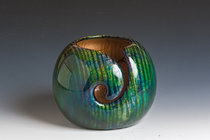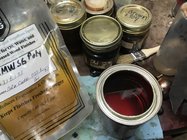I just turned my first "Jimmey Clewes" style platter, from a 14" AAA ripple figured maple platter blank. The ripple figure is incredible. The natural color of the wood is INCREDIBLE! I love the natural color of maple in general.
I am now at the point of finishing it...and I'm honestly not sure what finish to use. I really don't want to change the color of the wood, however I know anything based on linseed will yellow it significantly. Shellac (even the bleached blond stuff, in my experience) will yellow it. I have used Acks finishing polish in the past, which generally needs to be used with a sanding sealer, which are usually shellac based (or perhaps mylands which is cellulose based), and that also yellows the wood, although less than linseed oil finishes...so I am wary of trying the Acks approach in this piece. I know that polyurethane will yellow it, and yellow more over time (not to mention, that wouldn't necessarily be "food safe" (I know the definition of that term has changed a lot over time, and that for many finishes with solvents, after they evaporate, what remains is food safe, so I don't really want to get into that debate here...not sure if urethane falls into that class at all though)).
I am wondering what finishes are out there that will really bring out the chatoyance of the ripple figure in this wood, without changing the color beyond the normal darkening that most finishes introduce (I'm fine with the darkening). I mostly just don't want this beautiful piece to become yellow. I have done some work with Lacquer, and that is a heck of a LOT of work, and in the end I don't think I'll be able to keep the surface as smooth and neat as it is right now.
I've played around with polycrylic, but man, that stuff is really thick and does not really seem to bring out the chatoyance at all in my experience with it so far...but, maybe someone can convince me it can?
I've also looked into water-based urethanes. When I find comparisons between oil-based an water-based finishes, they almost universally say that the oil-based is better for bringing out the shimmer of chatoyance than water-based. Water-based generally contain more solids as well, and I am not sure if they would penetrate into the wood as well? I haven't tried a water-based urethane yet though, so I'm happy to hear what you more experienced woodworkers think.
Are there any other options out there for really bringing out the qualities of the wood grain, without coloring the wood?
I am now at the point of finishing it...and I'm honestly not sure what finish to use. I really don't want to change the color of the wood, however I know anything based on linseed will yellow it significantly. Shellac (even the bleached blond stuff, in my experience) will yellow it. I have used Acks finishing polish in the past, which generally needs to be used with a sanding sealer, which are usually shellac based (or perhaps mylands which is cellulose based), and that also yellows the wood, although less than linseed oil finishes...so I am wary of trying the Acks approach in this piece. I know that polyurethane will yellow it, and yellow more over time (not to mention, that wouldn't necessarily be "food safe" (I know the definition of that term has changed a lot over time, and that for many finishes with solvents, after they evaporate, what remains is food safe, so I don't really want to get into that debate here...not sure if urethane falls into that class at all though)).
I am wondering what finishes are out there that will really bring out the chatoyance of the ripple figure in this wood, without changing the color beyond the normal darkening that most finishes introduce (I'm fine with the darkening). I mostly just don't want this beautiful piece to become yellow. I have done some work with Lacquer, and that is a heck of a LOT of work, and in the end I don't think I'll be able to keep the surface as smooth and neat as it is right now.
I've played around with polycrylic, but man, that stuff is really thick and does not really seem to bring out the chatoyance at all in my experience with it so far...but, maybe someone can convince me it can?
I've also looked into water-based urethanes. When I find comparisons between oil-based an water-based finishes, they almost universally say that the oil-based is better for bringing out the shimmer of chatoyance than water-based. Water-based generally contain more solids as well, and I am not sure if they would penetrate into the wood as well? I haven't tried a water-based urethane yet though, so I'm happy to hear what you more experienced woodworkers think.
Are there any other options out there for really bringing out the qualities of the wood grain, without coloring the wood?
Last edited:


